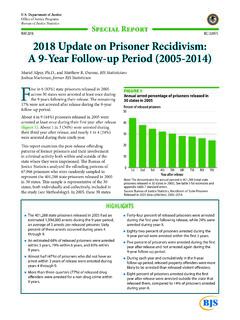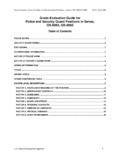Transcription of Correctional Populations in the United States, 2019 ...
1 Department of Justice Office of Justice Programs Bureau of Justice StatisticsBureau of Justice Statistics Statistical TablesJuly 2021, NCJ 300655 Correctional Populations in the United States, 2019 Statistical TablesAt year-end 2019, an estimated 6,344,000 persons were under the supervision of adult Correctional systems in the United States, about 65,200 fewer persons than in 2018 (figure 1). The adult Correctional system includes persons incarcerated in prisons and jails and persons supervised in the community on probation and parole. This was the first time since 1999 that the Correctional population dropped to less than The Correctional population declined by in 2019 and has declined an average of each year since 1 in 40 adult residents ( ) were under some form of Correctional supervision at the end of 2019. This represented a drop from 1 in 32 ( ) a decade the Key Statistics page on the BJS website at for Correctional population statstics prior to D.
2 Minton, Lauren G. Beatty, and Zhen Zeng, , BJS StatisticiansFIGURE 1 Number of persons under the supervision of adult Correctional systems in the , 2009 2019 Number (in millions)012345678 19 18 17 16 15 14 13 12 11 10 09 Incarcerated populationCommunity supervision populationTotal Correctional populationNote: Estimates may differ from previously published Methodology for more details. See Terms and definitions for more information and table 1 for : Bureau of Justice Statistics, Annual Probation Survey, Annual Parole Survey, National Prisoner Statistics program, 2009 2019; Annual Survey of Jails, 2009 2018; and Census of Jails, In 2019, the number of persons supervised by adult Correctional systems (6,344,000) decreased (down 65,200 persons) for the twelfth consecutive year. The decline in the Correctional population during 2019 was due to decreases in the community supervision (down ) and incarcerated (down ) Populations . Since 2009, the Correctional population decreased by (down 895,200 persons), an average of annually.
3 At year-end 2019, about 2,480 per 100,000 adult residents were under Correctional supervision, the lowest rate since 1991. By the end of 2019, the community supervision population had dropped to 4,357,700, its lowest level in the last two decades. All of the decrease in the community supervision population during 2019 was due to a decline in the probation population (down 47,100). In 2019, the incarcerated population fell to 2,086,600, its lowest level since 2003. The decline in the incarcerated population during 2019 was primarily due to a decrease in the prison population (down 33,600). From 2009 to 2019, the parole population grew by and was the only Correctional population with an overall increase during that Populations in the United States, 2019 Statistical Tables | July 2021 2 This report summarizes data from several Bureau of Justice Statistics (BJS) collections on Populations supervised by adult Correctional systems in the These systems include persons living in the community while supervised by probation or parole agencies and those incarcerated under the jurisdiction of state or federal prisons or in the custody of local jails.
4 (See Terms and definitions.) Other key findings Nearly 7 in 10 persons under Correctional supervision were supervised in the community (4,357,700) at year-end 2019, while about 3 in 10 (2,086,600) were incarcerated in state or federal prisons or local jails (table 1).22 The total Correctional , community supervision, and incarcerated Populations exclude offenders with dual Correctional statuses to avoid double counting. See table 5 and Methodology. Among persons under community supervision, the majority were on probation (3,492,900), while a smaller portion were on parole (878,900) at year-end 2019. While the probation population decreased (down ) during 2019, the parole population remained relatively stable (up ). Among persons incarcerated, 1,430,800 were under the jurisdiction of state or federal prisons and 734,500 were held in local jails in 2019. The prison population declined (or 33,600 persons) during 2019, resulting in the largest absolute population decline since 2015, while the change in the local jail population (down ) was not statistically significant.
5 From 2009 to 2019, the decrease in the probation population accounted for 79% of the total decline in the Correctional population (table 2). Despite the annual declines in the Correctional population since 2009, there were minimal changes in its composition (table 3): Probationers accounted for the majority of offenders under Correctional supervision in 2009 (58%) and 2019 (55%). Prisoners represented less than a quarter of the Correctional population (22% in 2009 and 23% in 2019). Parolees (11% in 2009 and 14% in 2019) and jail inmates (11% in 2009 and 12% in 2019) represented the smallest shares of the Correctional population. The community supervision rate declined annually during the last decade, dropping to a low of 1,700 per 100,000 adult residents on probation or parole by year-end 2019 (table 4). The incarceration rate dropped each year during the last decade, from 980 per 100,000 adult residents held in state or federal prisons or local jails at year-end 2009 to 810 per 100,000 at year-end 2019.
6 By the end of 2019, the incarceration rate had dropped to the same rate as 1995 (810 per 100,000 adult residents). Correctional Populations in the United States, 2019 Statistical Tables | July 2021 3 Terms and definitionsAdult A person subject to the jurisdiction of an adult criminal court or Correctional agency. Adults are age 18 or older in most jurisdictions. Persons age 17 or younger who were prosecuted in criminal court as if they were adults are counted as adults, but persons age 17 or younger who were under the jurisdiction of a juvenile court or agency are excluded. Local jails, however, may hold persons age 17 or younger before or after they are adjudicated. (See Methodology for more details on prisoners and local jail inmates age 17 or younger.)Community supervision population Estimated number of adults living in the community while supervised on probation or supervision rate Estimated number of adults living in the community while supervised on probation or parole per 100,000 residents of all ages ( , total community supervision rate) or residents age 18 or older ( , adult community supervision rate).
7 Correctional population Estimated number of adults living in the community while supervised on probation or parole and adults under the jurisdiction of state or federal prisons or in the custody of local jails. Correctional supervision rate Estimated number of adults supervised in the community on probation or parole and adults under the jurisdiction of state or federal prisons or in the custody of local jails per 100,000 residents of all ages ( , total Correctional supervision rate) or residents age 18 or older ( , adult Correctional supervision rate). Imprisonment rate Estimated number of prisoners under state or federal jurisdiction sentenced to more than one year per 100,000 residents of all ages ( , total imprisonment rate) or residents age 18 or older ( , adult imprisonment rate). This statistic does not appear in this report. (See Prisoners in 2019, NCJ 255115, BJS, October 2020.) Incarcerated population Estimated number of prisoners under the jurisdiction of state or federal prisons and inmates in the custody of local jails.
8 Incarceration rate Estimated number of prisoners under the jurisdiction of state or federal prisons and inmates in the custody of local jails per 100,000 residents of all ages ( , total incarceration rate) or residents age 18 or older ( , adult incarceration rate).Indian country jail population Estimated number of inmates held in Correctional facilities operated by tribal authorities or the Bureau of Indian Affairs (BIA), Department of the Interior. These facilities include confinement facilities, detention centers, jails, and other facilities operated by tribal authorities or the BIA. (See appendix table 2.) Local jail population Estimated number of inmates held in confinement facilities operated under the authority of a sheriff, police chief, or city or county administrator. Facilities are intended for adults but may hold juveniles before or after they are adjudicated. Facilities include jails, detention centers, city or county Correctional centers, special jail facilities (such as medical or treatment centers and prerelease centers) and temporary holding or lockup facilities that are part of the jail s combined function.
9 Inmates sentenced to jail facilities usually have a sentence of 1 year or less. Military prison population Estimated number of service personnel incarcerated under the jurisdiction of military Correctional authorities. (See appendix table 2.)Parole population Estimated number of parolees who are on conditional release in the community following a prison term while under the control, supervision, or care of a state or federal Correctional agency. Violations of the conditions of supervision during this period may result in a new sentence of confinement or a return to confinement for a technical violation. Parolees include adults released through discretionary or mandatory supervised release from population Estimated number of prisoners incarcerated in a long-term confinement facility run by a state or the federal government and typically holding felons and other offenders with sentences of more than 1 year, although sentence length may vary by jurisdiction population Estimated number of prisoners under the jurisdiction or legal authority of state or federal Correctional officials, regardless of where the prisoner is held.
10 This population represents the Bureau of Justice Statistics official measure of the prison population and includes prisoners held in public or private prisons, penitentiaries, Correctional facilities, halfway houses, boot camps, farms, training or treatment centers, and hospitals. Counts also include prisoners who were temporarily absent (less than 30 days); in court or on work release; housed in privately operated facilities, local jails, or other state or federal facilities; and serving concurrent sentences for more than one Correctional custody population Estimated number of prisoners held in the physical custody of state or federal prisons regardless of sentence length or the authority having jurisdiction. This population includes prisoners housed for other Correctional facilities but excludes prisoners in the custody of Continued on next pageCorrectional Populations in the United States, 2019 Statistical Tables | July 2021 4 Terms and definitions (continued)local jails, held in other jurisdictions, out to court, or in transit from one jurisdiction of legal authority to the custody of a confinement facility outside that jurisdiction.
















